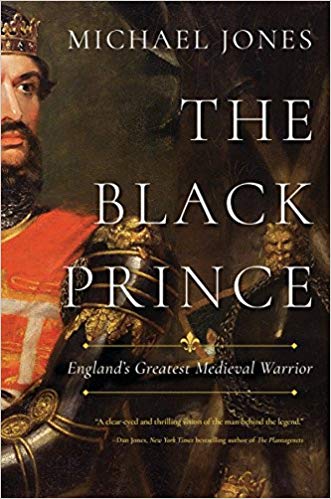Clad in gleaming armor, with gauntleted hands clasped in prayer, the life-size effigy of Edward “the Black Prince” in England’s Canterbury Cathedral is an iconic image of medieval knighthood. His tomb, decorated with shields displaying both the leopards of England and the lilies of France, highlights the dynastic clash in which Edward earned legendary status. During the first half of the sprawling Anglo-French conflict known as the Hundred Years’ War, his inspirational leadership helped to win memorable victories against heavy odds.
In his fine biography, Michael Jones resurrects the recumbent warrior, giving a vivid but scholarly portrait of the man extolled by the contemporary chronicler Jean Froissart as “the very flower of chivalry.” Mr. Jones maintains that Edward deserved such accolades, having strived to exemplify the lofty ideals of the knight’s code.
Yet “The Black Prince” is no hagiography, and it doesn’t ignore such flaws as the prince’s unbridled extravagance and lack of political finesse. Nor does it minimize the suffering inflicted by his military activities. Although the prince’s striking soubriquet was never used in his own lifetime, and its origin remains unclear, some historians have attributed it to a dark reputation acquired during his devastating raids through France.
Edward was born in 1330, the eldest son of King Edward III of England, whose own father, the ineffective Edward II, had been deposed by his wife and her lover and eventually murdered. Edward III, having toppled the pair and asserted his own royal authority at age 17, sought to bind his nobles to him through the camaraderie of war, waged first against Scotland and, later, against the mightier realm of France.
From childhood, Prince Edward was groomed to become his father’s staunch helper, ready to rule and fight. He was fitted for his first suit of armor at 7; by 13, he was competing in tournaments that trained him in horsemanship and combat. Soon he had a chance to test his skills in battle.
Edward III, after claiming the crown of France by right of his mother, invaded Normandy in 1346. His 16-year-old son was knighted when the army landed, but it was at Crécy, in August, that he truly “won his spurs,” helping to inflict a crushing defeat on the far larger army of the French king, Philip VI. French casualties included Jean of Luxembourg, the “blind King of Bohemia,” who, determined to strike a blow against his unseen enemies, asked his knights to guide him into battle by tethering their horses to his. They were found the next morning, united in death. Moved by such loyalty, the Black Prince adopted Jean’s badge of an ostrich feather as his own heraldic device.
War was soon subsumed by a greater catastrophe: the Black Death. Reaching England in the summer of 1348, this outbreak of bubonic plague killed between a third and a half of the population. Rank conferred no immunity: The prince’s sister Joan succumbed. Those left alive exhibited what Mr. Jones characterizes as “the defiance of plague survivors—willing to meet death head-on, without fear.”
Such resolution characterized the Black Prince’s finest exploit. In the summer of 1356, he led an army north from Gascony, part of the English-occupied Duchy of Aquitaine in southwestern France. He aimed to rendezvous with other English forces but was intercepted by a massive French army headed by King John II. Outnumbered 3 to 1, the Black Prince deployed his 6,000-strong Anglo-Gascon force in a strong defensive position near Poitiers. Addressing his men, he made it clear that they would win or die together, declaring: “We all drink from the same cup.”
Most of the French knights at Poitiers—heeding the lessons of Crécy, where their unarmored horses were felled by the enemy’s longbowmen—fought dismounted. After hours of combat, it seemed that the prince’s exhausted men would be overwhelmed. The battle was decided when Edward mounted up his troops and led them in a desperate charge that stunned the French. Their army dissolved, with thousands killed or captured. The haul of prisoners included King John and his son Philip.
With his enemies leaderless, Edward III moved to exploit the chaos, gaining territories equal to a third of modern France. They included Aquitaine, where he installed the Black Prince as ruler in recognition of his services.
As Europe’s most eligible bachelor, the prince could take his pick of royal brides. Defying expectations, he married his widowed cousin, Joan of Kent. It was a happy match: In his letters, the prince addressed her as his “dearest and truest sweetheart.” At his court at Bordeaux, she set a fashion for tight-fitting dresses with daringly low-cut bodices.
But the zenith of the prince’s fame marked the start of his decline. In 1366, he agreed to help Pedro of Castile regain his throne from his bastard brother Enrique. Edward led his veterans in an epic march across the Pyrenees and easily defeated Enrique in April 1367. But Pedro sickened his chivalrous benefactor by cold-bloodedly murdering his prisoners and failed to pay his share of the expedition’s costs. The Black Prince, cash-strapped by his lavish lifestyle, imposed taxation that stirred discontent in Aquitaine, and the new French king, Charles V, was quick to exploit it.
When war recommenced in 1369, the Black Prince was ailing with the mysterious illness from which he would die seven years later. When he learned that the city of Limoges had defected to the French, he angrily ordered its recapture. According to the chronicler Froissart, the assault in September 1370 was followed by a vindictive massacre of 3,000 civilians. The episode has long blotted the prince’s reputation, and Mr. Jones offers a vigorous rebuttal, accusing Froissart—who was reluctant to let the facts get in the way of a good story—of grossly exaggerating the death toll. Here and throughout his informed and insightful book, Mr. Jones makes a convincing argument that in life the Black Prince embodied the chivalric aura that radiates from his splendid effigy.
(Stephen Brumwell, Wall Street Journal.)


